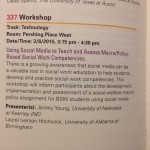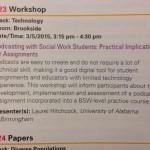Follow-up to Live Twitter Chat on March 12, 2015
This is a short post to follow-up on the second live #MacroSW chat that Jimmy Young and I hosted on March 12, 2015 about the documentary Inequality for All. Once again, we had a great turnout and an inspired conversation. Others have written more about this chat, so I am going to direct you to their posts:
1. Chat Statistics: The #MacroSW Chat folks reported that there were almost 100 people on the chat who shared 640 posts in one hour. Here is a link to more analytics about the chat.
2. Chat Transcript: Here is a link to the chat transcript in Storify, a web-based program marketed as a story-telling software. It also is a great tool for summarizing tweets from live chats and other types of conversations on Twitter.
3. Chat Summary: Jimmy Young wrote a solid summary of the chat from the perspective of a social work educator. Like Jimmy, I find live Twitter chats a compelling learning tool for bachelor-level social work students. During the chats, I see students engaging in public discourse on vital policy issues with their peers and other professionals, not just in the classroom. They are actively connecting with others, sharing and thinking critically about poverty issues when participating in a live chat. Look for more information near future from Jimmy and I about using live Twitter chats in the social work classroom.
Again, many thanks to #MacroSW chat and our host from @MSWatUSC, Kristin Battista-Frazee (@porndaughter). They sponsored, promoted and summarized the chat, and are all around great people! Also, a big thanks to all the students, educators and practitioners who showed up and participated in our national conversation – including social work students and educators from University of Buffalo, University of Tennessee, University of Nebraska at Kearney University of Alabama at Birmingham, and Jacksonville State University to name a few.
How to cite this post:
Hitchcock, L. I. (2015, March 16). Follow-up to Live Twitter Chat on March 12, 2015[Blog Post]. Retrieved from https://laureliversonhitchcock.org/2015/03/16/follow-up-to-live-twitter-chat-on-march-12-2015/.
Using Social Media to teach and assess Macro/Policy-based Social Work Competencies – #BPD2015 Conference
 Today, I am pres
Today, I am pres enting with Dr. Jimmy Young at the Association of Baccalaureate Social Work Program Director’s Annual 2015 Conference (3/6/15) about our social media assignment designed for social work students to learn about and try their hand at macro- and policy-practice skills. In this workshop, we will describe how we developed, implemented and assessed this assignment which incorporates a documentary movie with a live Twitter chat. We will discuss things we learned along the way and offer tips on how other educators can incorporate a similar assignment into their courses. The learning objectives for this session include:
enting with Dr. Jimmy Young at the Association of Baccalaureate Social Work Program Director’s Annual 2015 Conference (3/6/15) about our social media assignment designed for social work students to learn about and try their hand at macro- and policy-practice skills. In this workshop, we will describe how we developed, implemented and assessed this assignment which incorporates a documentary movie with a live Twitter chat. We will discuss things we learned along the way and offer tips on how other educators can incorporate a similar assignment into their courses. The learning objectives for this session include:
1. Understand how the social media platform Twitter can be incorporated into assignments for social work policy courses at the BSW-level.
2. Demonstrate how social work educators can assess attainment of competency among BSW students using a social media assignment paired with a Rubric for evaluation of the assignment’s learning outcomes.
3. Appreciate the role of professional collaboration in the development, implementation and assessment of social media-based assignments.
We have previously written about this assignment on our blogs:
Special #MacroSW Chat October 28th at 8pm CST from JimmySW’s Blog
Follow-up to 10/28 #MacroSW Twitter Chat from Teaching Social Work Blog:
Here is a link to the Prezi that we will show during the presentation.
Our next live Twitter chat for this assignment will be on March 12, 2015 9 PM EST/8 PM CST and we invite you all to join us. The chat is sponsored by #MacroSW. Click here for more details.
Podcasting with Social Work Students – #BPD2015 Conference
I am presenting at the Association of Baccalaureate Social Work Program Director’s Annual 2015 Conference today (3/5/15) about podcasting with social work students, focusing on practical implications for course-based assignments. In this workshop, I will describe how I developed a podcast assignment for BSW students and will offer tips on how other educators can incorporate a similar assignment into their courses. The learning objectives for this session include:
1.Understanding how podcasting can be incorporated into assignments for social work courses at the BSW-level;
2. Describing how social work educators can assess attainment of competency among BSW students using a social media assignment; and
3. Appreciating the role of professional collaboration in the development, implementation and assessment using podcasting.
This presentation is based on a series of blog posts I wrote last year about podcasting in social work education:
1. Podcasting for Social Work Students, Part 1 – Describing the Assignment (1/16/14)
2. Podcasting for Social Work Students, Part 2 – Why use podcasting in the classroom (1/31/14)
Here is a link to the Prezi that I will show during the presentation (http://tiny.cc/PodcastPrezi_BPD2015).
Workshop for Alabama Conference on Social Work – 2/27/15
It is almost the end of February and I find myself in Orange Beach, Alabama presenting at the 2015 Annual Conference of the Alabama Conference on Social Work. The purpose of this post is to provide supplemental information for my presentation. The title is Professional and Ethical Use of Social Media in Social Work Practice, and the presentation will focus on the need for social workers to be aware of and adept at using social media in two important ways. First, social media can be valuable tools for professional development and continuing education. Platforms such as LinkedIn, Twitter and professional websites provide valuable information and resources for practice and opportunities to network and collaborate with other practitioners. To effectively engage with social media for professional development, social workers need to know how to create digital identities; consume, assess and produce online content; collaborate with others; and educate and motivate other professionals to use social media. Second, social workers need to understand how to effectively engage client systems with social media. This includes a range of knowledge and skills from maintaining ethical professional boundaries to educating clients on how to find credible online resources to advocating for those who do not have access to the internet in low-income or rural communities.
By the end of the presentations, participants will be able to:
1. Explain why social workers need to understand social media and digital literacy
2. Discuss the knowledge, skills and values associated with professional use of social media
3. Reflect on own use social media in a professional context
Here is a link to the Prezi presentation that I will show during the workshop and here is a link to a resource handout for the participants.
How to cite this post:
Hitchcock, L. I . (2015, February 27).Workshop for Alabama Conference on Social Work – 2/27/15[Blog Post]. Retrieved from https://laureliversonhitchcock.org/2015/02/27/workshop-acsw-2015/.
Using Google Plus Hangouts in Social Work Education
Dr. Jandel Crutchfield is a visiting assistant professor in the Department of Social Work at the University of Mississippi. In this blog post, she writes about using Google Plus Hangouts to promote synchronous experiences in her online courses.
Until August 2014, my background in online social work education was solely in asynchronous instruction through platforms including Moodle and Blackboard. Some of the feedback from students in my courses highlighted a lack of “real” interaction with me as their professor. To address this initially, I began to record short video lectures for students to receive some another method of instruction and interaction besides text. Though this improved some student experiences, I still received feedback that students wanted more interaction with me; or that “something was missing.” Due to university regulations, however, there was little else I could do to enhance the asynchronous experience.
After joining University of Mississippi, Department of Social Work in 2014 and being offered the opportunity to teach online, I began to research ways to conduct completely synchronous session. Since many of the students had not had multiple online courses and were new to the social work department, I wanted to find a way to avoid overwhelming students with the delivery format. I found Google Plus Hangouts (which is a free video conference calling tool from Google), got it approved by the online learning department, and began learning how to use it to conduct synchronous sessions. I studied the online users’ guides from Google and activated my University Gmail account. Then I began to invite friends to participate in video calls and hangouts on air. I recorded several “test” sessions and practiced uploading them to Blackboard to view what students would see after I had shared a recording. I got feedback from my colleagues and friends that participated on the video calls and hangouts on air. I found Google Plus Hangouts to be very user friendly and integrated into larger society more than programs such as Adobe Connect or even Skype. Nearly everyone had at least heard of Google, which would facilitate usage even beyond the classroom for instructors and students alike. Also, Google Plus Hangouts did not require a license or other monitoring by the university technology department.





